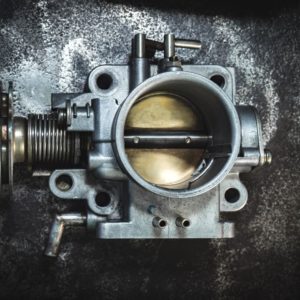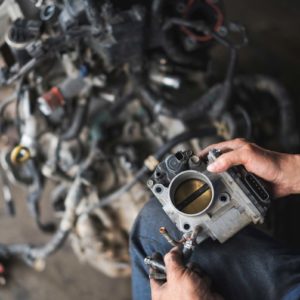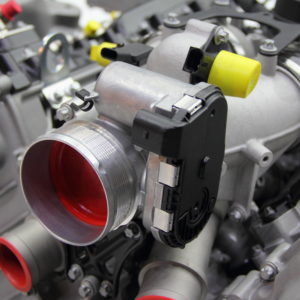The P2110 code may indicate a potential problem with your vehicle’s throttle actuator control system. If your check engine light is on and the P2110 code registers on your OBD-II scan tool, you’ll want to know what it means. This brief guide will help you find out what the engine code P2110 means, as well as its possible causes and common symptoms.
What Does the P2110 Code Mean?
Diagnostic trouble code (DTC) P2110 stands for “Throttle Actuator Control System – Forced Limited RPM.” It’s triggered when the vehicle’s powertrain control module (PCM) detects a potential problem with the electronic throttle control system (ECTS).

Electronic throttle body systems virtually always have redundant sensors, both on the accelerator pedal as well as on the throttle body. This is good engineering, because when an electronic module is in control of the throttle, a single sensor can’t be trusted to provide reliable input.
Typically, P2110 is a code and condition triggered when redundant sensors disagree, either because of a problem with a sensor or a sensor circuit, i.e., shorted or open wiring.
The ECTS is responsible for controlling the throttle valve opening. When the accelerator pedal is pressed, the accelerator pedal position (APP) sensors sends signals to the PCM indicating how much power the engine needs to produce. The PCM then commands the throttle plate to open accordingly while applying throttle plate position feedback from the redundant TP sensors on the throttle body.
When the PCM detects signals from the ECTS that do not meet the specified range or that any of the redundant sensor signals don’t agree, the P2110 sets. The PCM then limits the operation of the throttle actuator control system by activating a fail-safe or limp home mode. This mode prevents unwanted acceleration by limiting the engine’s power or RPM. Typically, a dedicated warning light or an instrument cluster message will be triggered at this point.
Note: The definition of code P2110 may be different depending on the vehicle manufacturer. Consult the appropriate repair manual or repair database for the exact code definition.
What Are the Possible Causes of the P2110 Code?
All OBD-II codes have multiple possible causes. As for the P2110 code, there are several possibilities. These include the following:

- Faulty accelerator pedal position assembly
- Faulty throttle control motor
- Wiring issue(s)
- PCM failure
What Are the Common Symptoms of the P2110 Code?
Below are some of the most common symptoms of the P2110 engine code:
- Check engine light or malfunction indicator lamp (MIL) is illuminated
- Illuminated ABS light
- Decreased engine performance (engine may not start, etc.)
- Minimal or no throttle response
- Automatic transmission will not shift
- Engine may go into limp home mode
- Additional codes may also be present
How to Diagnose the P2110 Code
As mentioned above, there are a few things that can trigger the P2110 code. Diagnosing this issue may require the experience and expertise of a seasoned mechanic or technician.
However, if you want to do your own research and know more about this code, there are a few resources that explain this trouble code’s diagnosis and repair in more detail.
Below is a video that demonstrates what the diagnostic process might involve:
How to Fix the P2110 Code
Note: Handling throttle bodies without having significant DIY automotive experience can lead to serious injuries. Read our reminder about handling the throttle body.
Even though many trouble codes share the same symptoms, probable causes, and affected areas, there are no common fixes for DTCs. Before you can fix the P2110 code, you have to find out its exact cause and determine the prescribed repair procedure for your specific vehicle.
There are a lot of auto repair resources and guides to help you figure out the right fix. One of the best and most reliable resources is a vehicle-specific repair manual. These manuals are written for your vehicle’s exact make and model and have detailed repair information, as well as illustrations and diagrams to help you understand the issue better.
Just note that it may be best to let a mechanic diagnose and fix this problem, especially if you’re not familiar with trouble codes and how to troubleshoot them.
Other Notes About P2110
The P2110 engine code is one of the four force codes. The other force codes are P2104, P2105, and P2106. The PCM sets these force codes when codes that indicate safety issues or severe engine and drivetrain problems are present.
If the P2110 engine code is set, you need to bring your vehicle to a professional for diagnosis and repair immediately. Driving with this code is not recommended.
Any information provided on this Website is for informational purposes only and is not intended to replace consultation with a professional mechanic. The accuracy and timeliness of the information may change from the time of publication.


















